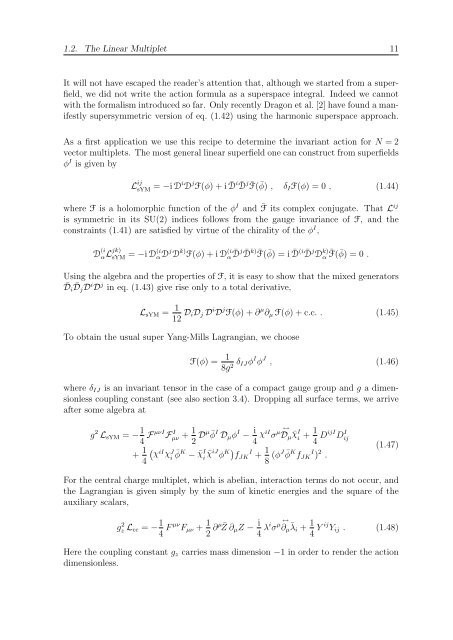N=2 Supersymmetric Gauge Theories with Nonpolynomial Interactions
N=2 Supersymmetric Gauge Theories with Nonpolynomial Interactions
N=2 Supersymmetric Gauge Theories with Nonpolynomial Interactions
You also want an ePaper? Increase the reach of your titles
YUMPU automatically turns print PDFs into web optimized ePapers that Google loves.
1.2. The Linear Multiplet 11<br />
It will not have escaped the reader’s attention that, although we started from a superfield,<br />
we did not write the action formula as a superspace integral. Indeed we cannot<br />
<strong>with</strong> the formalism introduced so far. Only recently Dragon et al. [2] have found a manifestly<br />
supersymmetric version of eq. (1.42) using the harmonic superspace approach.<br />
As a first application we use this recipe to determine the invariant action for N = 2<br />
vector multiplets. The most general linear superfield one can construct from superfields<br />
φ I is given by<br />
L ij<br />
sYM = −i Di D j F(φ) + i ¯ D i ¯ D j ¯ F( ¯ φ) , δIF(φ) = 0 , (1.44)<br />
where F is a holomorphic function of the φ I and ¯ F its complex conjugate. That L ij<br />
is symmetric in its SU(2) indices follows from the gauge invariance of F, and the<br />
constraints (1.41) are satisfied by virtue of the chirality of the φ I ,<br />
D (i<br />
αL jk)<br />
sYM = −i D(i αD j D k) F(φ) + i D (i<br />
α ¯ D j D¯ k)<br />
F( ¯ φ) ¯ = i D ¯ (i<br />
D¯ j k)<br />
D ¯<br />
α F( φ) ¯ = 0 .<br />
Using the algebra and the properties of F, it is easy to show that the mixed generators<br />
¯Di ¯ DjD i D j in eq. (1.43) give rise only to a total derivative,<br />
LsYM = 1<br />
12 DiDj D i D j F(φ) + ∂ µ ∂µ F(φ) + c.c. . (1.45)<br />
To obtain the usual super Yang-Mills Lagrangian, we choose<br />
F(φ) = 1<br />
8g 2 δIJφ I φ J , (1.46)<br />
where δIJ is an invariant tensor in the case of a compact gauge group and g a dimensionless<br />
coupling constant (see also section 3.4). Dropping all surface terms, we arrive<br />
after some algebra at<br />
g 2 LsYM = − 1<br />
4 F µνI F I µν + 1<br />
2 Dµ φ¯ I<br />
Dµφ I − i<br />
4 χiI ↔<br />
µ<br />
σ Dµ ¯χI<br />
i + 1<br />
+ 1 <br />
χiIχ 4<br />
J i ¯ φ K − ¯χ I<br />
i ¯χiJφ K fJK I + 1<br />
8 (φJφ¯ K<br />
fJK I ) 2 .<br />
4 DijI D I ij<br />
(1.47)<br />
For the central charge multiplet, which is abelian, interaction terms do not occur, and<br />
the Lagrangian is given simply by the sum of kinetic energies and the square of the<br />
auxiliary scalars,<br />
g 2 z Lcc = − 1<br />
4 F µν Fµν + 1<br />
2 ∂µ¯ Z ∂µZ − i<br />
4 λi ↔<br />
µ<br />
σ ∂µ ¯ λi + 1<br />
4 Y ij Yij . (1.48)<br />
Here the coupling constant gz carries mass dimension −1 in order to render the action<br />
dimensionless.

















